A Method for Determination of the Transmission Efficiency of a Silica Optical Fiber Cable Using a Solar Power Tower
Abstract
1. Introduction
2. Efficiency of Optical Fibers for Sunlight Transmission
3. Experimental
3.1. The Optical Fiber Bundle
3.2. Solar Testing Facility
3.3. Experimental Layout, Sensors, and Other Apparatuses Used in the Tests
- a pyrheliometer (SHP1-A, Kipp and Zonen, Delft, The Netherlands) mounted on a sun tracker, to monitor the direct normal irradiance (DNI) reaching the heliostats;
- two Gardon-type radiometers (Vatell Circular-Foil Heat Flux Transducer TG1000-1, Vatell Corporation, Christiansburg, VA, USA) to measure the input and output radiation flux of the optical fiber bundle/cable;
- a water chiller (model Huber Unichiller 003-MPC, Huber Kältemaschinenbau AG, Offenburg Germany) to lower the temperature of the Gardon-type radiometers;
- a white screen made of plates of alumina to protect the testing room at the VHCST from the effects of the concentrated solar radiation;
- a CCD camera and software (GT1930L, Allied Vision, Stadtroda, Germany) to monitor the distribution of radiation flux over the white screen;
- several K-type thermocouples (TC Ltd., Uxbridge, UK) to monitor the temperature at different locations over the white screen, as well as the temperature close to the entrance of the optical fiber bundle/cable;
- an optical converging system to re-concentrate the radiation at the outlet of the cable. The converging system (constructed at Instituto Superior Técnico, Lisbon, Portugal) is composed of two identical plano-convex lenses made of silica glass, as described in the work of Rosa et al. [42];
- a LabVIEW system for data acquisition and monitoring of temperature and radiation flux along time.
3.4. Testing Procedure
4. Results and Discussion
5. Conclusions
Author Contributions
Funding
Institutional Review Board Statement
Informed Consent Statement
Data Availability Statement
Acknowledgments
Conflicts of Interest
References
- Gareiou, Z.; Drimili, E.; Zervas, E. Public acceptance of renewable energy sources. In Low Carbon Energy Technologies in Sustainable Energy Systems; Kyriakopoulos, G.L., Ed.; Academic Press: Cambridge, MA, USA, 2021; pp. 309–327. ISBN 9780128228975. [Google Scholar] [CrossRef]
- Kalogirou, S.A. Renewable energy systems: Current status and prospects. In Solar Energy Conversion in Communities; Visa, I., Duta, A., Eds.; Springer Proceedings in Energy; Springer: Cham, Switzerland, 2020; pp. 451–454. [Google Scholar] [CrossRef]
- Stemmer, J. INSHIP—Solar Heat For Industrial Processes. European Energy Innovation Website. 2018. Available online: https://www.europeanenergyinnovation.eu/Latest-Research/Autumn-2018/INSHIP-Solar-heat-for-industrial-processes (accessed on 29 January 2022).
- Rahou, M.; Mojiri, A.; Rosengarten, G.; Andrews, J. Optical design of a Fresnel concentrating solar system for direct transmission of radiation through an optical fibre bundle. Sol. Energy 2015, 124, 15–25. [Google Scholar] [CrossRef]
- Li, X.L.; Fan, G.H.; Zhang, Y.Q.; Ji, X.F.; Li, M. A fresnel concentrator with fiber-optic bundle based space solar power satellite design. Acta Astronaut. 2018, 153, 122–129. [Google Scholar] [CrossRef]
- Rosa, L.G. Solar heat for materials processing: A review on recent achievements and a prospect on future trends. ChemEngineering 2019, 3, 83. [Google Scholar] [CrossRef]
- Pereira, J.C.G.; Fernandes, J.C.; Rosa, L.G. Mathematical models for simulation and optimization of high-flux solar furnaces. Math. Comput. Appl. 2019, 24, 65. [Google Scholar] [CrossRef]
- Pereira, J.C.G.; Rodríguez, J.; Fernandes, J.C.; Rosa, L.G. Homogeneous flux distribution in high-flux solar furnaces. Energies 2020, 13, 433. [Google Scholar] [CrossRef]
- Kato, D.; Nakamura, T. Application of optical fibers to the transmission of solar radiation. J. Appl. Phys. 1976, 47, 4528–4531. [Google Scholar] [CrossRef]
- Cariou, J.M.; Martin, L.; Dugas, J. Concentrated solar energy transport by optical fibers. In Advances in Ceramics, Vol. II, Physics of Fiber Optics; Bendow, B., Mitra, S.S., Eds.; American Ceramics Society: Columbus, OH, USA, 1981; pp. 557–563. ISBN 9780916094423. [Google Scholar]
- Cariou, J.M.; Dugas, J.; Martin, L. Transport of solar energy with optical fibres. Sol. Energy 1982, 29, 397–406. [Google Scholar] [CrossRef]
- Kandilli, C.; Ulgen, K. Review and modelling the systems of transmission concentrated solar energy via optical fibres. Renew. Sustain. Energy Rev. 2009, 13, 67–84. [Google Scholar] [CrossRef]
- Zidani, C.; Benyoucef, B.; Madini, N. Optimization of photothermal system based on the idea of transmission solar energy via optical fibres. Phys. Procedia 2014, 55, 493–502. [Google Scholar] [CrossRef][Green Version]
- Liang, D.; Fraser Monteiro, L.; Ribau Teixeira, M.; Fraser Monteiro, M.L.; Collares-Pereira, M. Fibre-optic solar energy transmission and concentration. Sol. Energy Mater. Sol. Cells 1988, 54, 323–331. [Google Scholar] [CrossRef]
- Feuermann, D.; Gordon, J.F.; Huleihil, M. Solar fiber optic mini-dish concentrators: First experimental results and field experience. Sol. Energy 2002, 72, 459–472. [Google Scholar] [CrossRef]
- Zik, O.; Karni, J.; Kribus, A. The TROF (Tower Reflector with Optical Fibers): A new degree of freedom for solar energy systems. Sol. Energy 2000, 67, 13–22. [Google Scholar] [CrossRef]
- Kribus, A.; Zik, O.; Karni, J. Optical fibers and solar power generation. Sol. Energy 2000, 68, 405–416. [Google Scholar] [CrossRef]
- González, A.; González-Aguilar, J.; Romero, M. Preliminary Analysis of a 100-kWth Mini-Tower Solar Field with an Integrated Optical Waveguide Receiver for Solar Chemistry. In Proceedings of the ASME 2010 4th International Conference on Energy Sustainability, Phoenix, AZ, USA, 17–22 May 2010; Paper No: ES2010-90194. pp. 543–552. [Google Scholar] [CrossRef]
- Nakamura, T. Optical Waveguide System for Solar Power Applications in Space. In Nonimaging Optics: Efficient Design for Illumination and Solar Concentration VI, 74230C; SPIE: Bellingham, WA, USA, 2009. [Google Scholar] [CrossRef]
- Nakamura, T.; Smith, B.K. Solar Thermal System for Lunar ISRU Applications: Development and Field Operation at Mauna Kea, HI. In Nonimaging Optics: Efficient Design for Illumination and Solar Concentration VIII, 81240B; SPIE: Bellingham, WA, USA, 2011. [Google Scholar] [CrossRef]
- Nakamura, T.; Smith, B.K.; Irvin, B.R. Optical waveguide solar power system for material processing in space. J. Aerosp. Eng. 2015, 28, 04014051. [Google Scholar] [CrossRef]
- Tricker, R. Optical Fibres in Power Systems. In Electrical Engineer’s Reference Book, 16th ed.; Warne, D.F., Laughton, M.A., Eds.; Newnes: London, UK, 2003; pp. 37-1, 37-3–37-17. [Google Scholar] [CrossRef]
- Song, J.F.; Wang, J.T.; Niu, Y.S.; Wang, W.M.; Tong, K.; Yu, H.; Yang, Y.P. Flexible high flux solar simulator based on optical fiber bundles. Sol. Energy 2019, 193, 576–583. [Google Scholar] [CrossRef]
- Lv, Y.X.; Xia, L.Y.; Yan, J.Y.; Bi, J.P. Design of a hybrid fiber optic daylighting and PV solar lighting system. Energy Procedia 2018, 145, 586–591. [Google Scholar] [CrossRef]
- Al-Amayreh, M.I.; Alahmer, A.; Manasrah, A.A. A novel parabolic solar dish design for a hybrid solar lighting-thermal applications. Energy Rep. 2020, 6, 1136–1143. [Google Scholar] [CrossRef]
- Roy, J.S.; Morency, S.; Dugas, G.; Messaddeq, Y. Development of an extremely concentrated solar energy delivery system using silica optical fiber bundle for deployment of solar energy: Daylighting to photocatalytic wastewater treatment. Sol. Energy 2021, 214, 93–100. [Google Scholar] [CrossRef]
- Tong, K.; Chen, L.; Yang, L.J.; Du, X.Z.; Yang, Y.P. Energy transport of photocatalytic carbon dioxide reduction in optical fiber honeycomb reactor coupled with trough concentrated solar power. Catalysts 2021, 11, 829. [Google Scholar] [CrossRef]
- Ziemann, O.; Krauser, J.; Zamzow, P.E.; Daum, W. Application of Polymer Optical and Glass Fibers. In POF Handbook; Springer: Berlin/Heidelberg, Germany, 2008; pp. 593–663. [Google Scholar] [CrossRef]
- Luan, X.G.; Xu, X.M.; Li, M.; Yu, R.; Zhang, Q.Q.; Zhang, S.; Cheng, L.F. Design, preparation, and properties of a boron nitride coating of silica optical fiber for high temperature sensing applications. J. Alloys Compd. 2021, 850, 156782. [Google Scholar] [CrossRef]
- Liang, D.W.; Pires, N.; Chaves, J.; Semedo, J.; Monteiro, L.F.; Monteiro, M.L.F.; Collares-Pereira, M. Solar Energy Transmission and Concentration by an Optical Fiber Bundle with a Frustum-Type Output End. In Nonimaging Optics: Maximum Efficiency Light Transfer V; SPIE: Bellingham, WA, USA, 1999. [Google Scholar] [CrossRef]
- Granta Design. CES EduPack 2016 Version: 16.1.22; Granta Design Limited: Cambridge, UK, 2016. [Google Scholar]
- RefractiveIndex. INFO Website: © 2008–2021 Mikhail Polyanskiy. Available online: https://refractiveindex.info/ (accessed on 1 September 2021).
- Oliver, S.; Proctor, B.A.; May, C.A.; Annamalai, V.E. Degradation of Glass and Glass Ceramics. In Reference Module in Materials Science and Materials Engineering; Elsevier: Amsterdam, The Netherlands, 2016. [Google Scholar] [CrossRef]
- O’Riorden, S.; Mahapatra, A. Protection of Silica Based Fiber Optics in a High Moisture Environment. Linden Photonics, Inc., USA, May 2017. Available online: http://www.lindenphotonics.com/documents/Linden%20-%20Protection%20of%20Silica%20Based%20Fiber%20Optics%20in%20a%20High%20Moisture%20Environment.pdf (accessed on 1 September 2021).
- Optran® UV NSS Silica Fiber with Hermetic Carbon Layer. Available online: https://www.ceramoptec.com/fileadmin/user_upload/pdf/pdf_data_sheets_neu_Aug2019/englisch_Aug2019/CeramOptec_Optran_UV_NSS_EN_11.pdf (accessed on 28 September 2021).
- Kasap, S.O. Optical Properties of Materials. In Principles of Electronic Materials and Devices, 4th ed.; McGraw-Hill Education: New York, NY, USA, 2018; pp. 859–939. [Google Scholar]
- Stone, J.A.; Zimmerman, J.H. Refractive Index of Air Calculator: A Web-Based Tool for Calculating the Index of Refraction of Air and Wavelength of Light in Air as a Function of Various Input Parameters, Using the Ciddor Equation or a Modified Version of the Edlén Equation. Available online: https://emtoolbox.nist.gov/Wavelength/ciddor.asp (accessed on 22 December 2021).
- Ceram Optec SIA. Available online: https://www.ceramoptec.com/contact-us.html (accessed on 22 December 2021).
- Romero, M.; González-Aguilar, J.; Luque, S. Ultra-modular 500m2 heliostat field for high flux/high temperature solar-driven processes. AIP Conf. Proc. 2017, 1850, 030044. [Google Scholar] [CrossRef]
- Romero, M.; González-Aguilar, J.; Sizmann, A.; Batteiger, V.; Falter, C.; Steinfeld, A.; Zoller, S.; Brendelberger, S.; Lieftink, D. Solar-driven thermochemical production of sustainable liquid fuels from H2O and CO2 in a heliostat field. In Proceedings of the ISES Solar World Congress 2019, Santiago, Chile, 4–7 November 2019. published by International Solar Energy Society (Open Access). [Google Scholar] [CrossRef]
- Martínez-Hernández, A.; Gonzalo, I.B.; Romero, M.; González-Aguilar, J. Drift analysis in tilt-roll heliostats. Sol. Energy 2020, 211, 1170–1183. [Google Scholar] [CrossRef]
- Rosa, L.G.; Pereira, J.C.G.; Rahmani, K.; De Almeida, G.; Santos, L.F. Study on the performance of optical lenses under high fluxes of solar radiation. Appl. Sci. 2021, 11, 5174. [Google Scholar] [CrossRef]
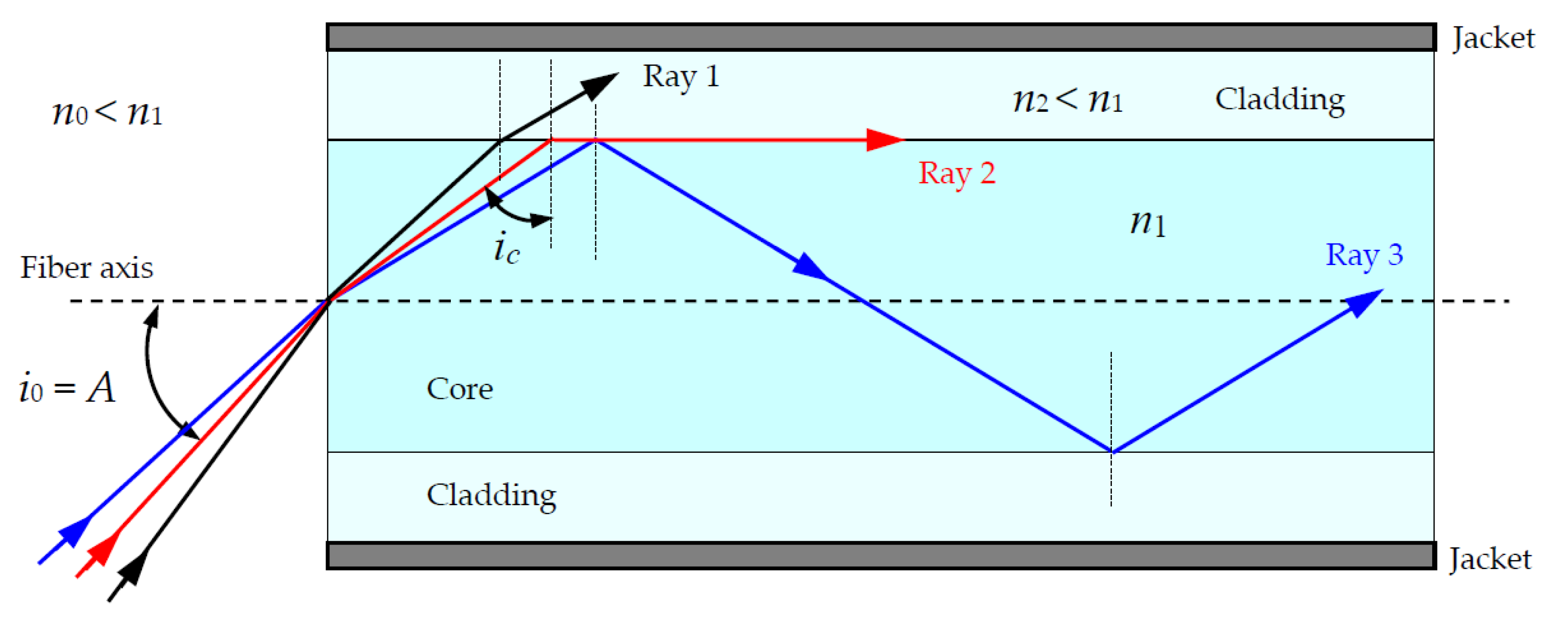
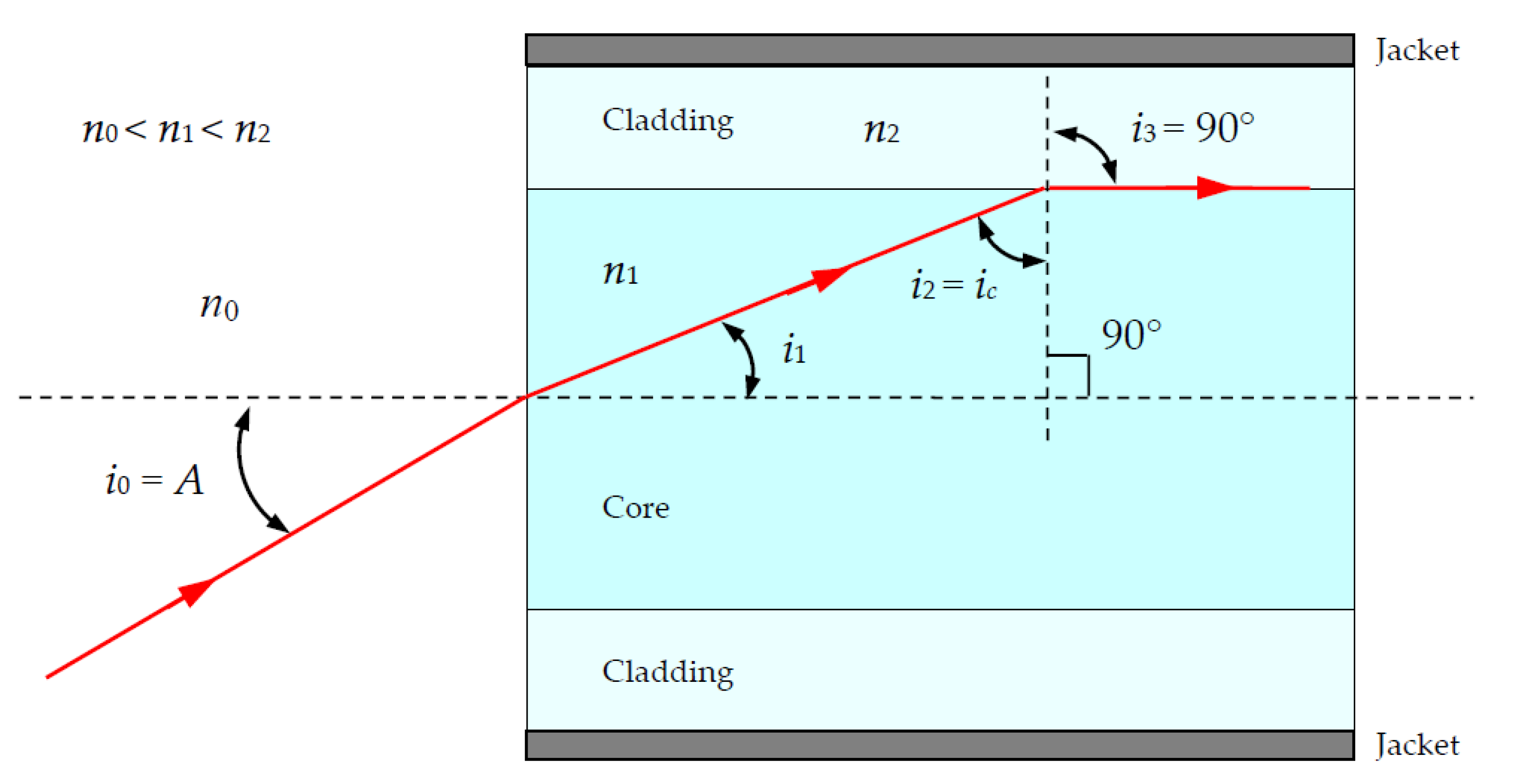
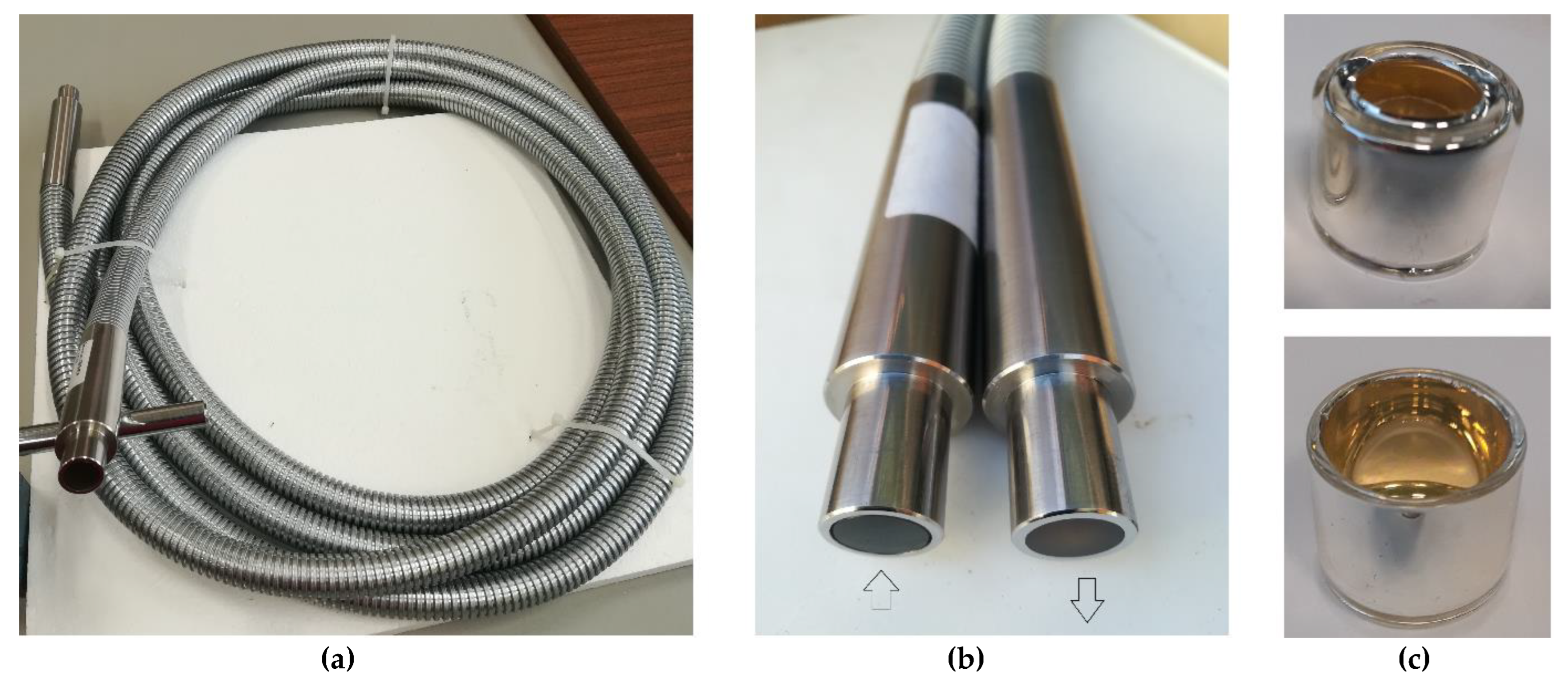
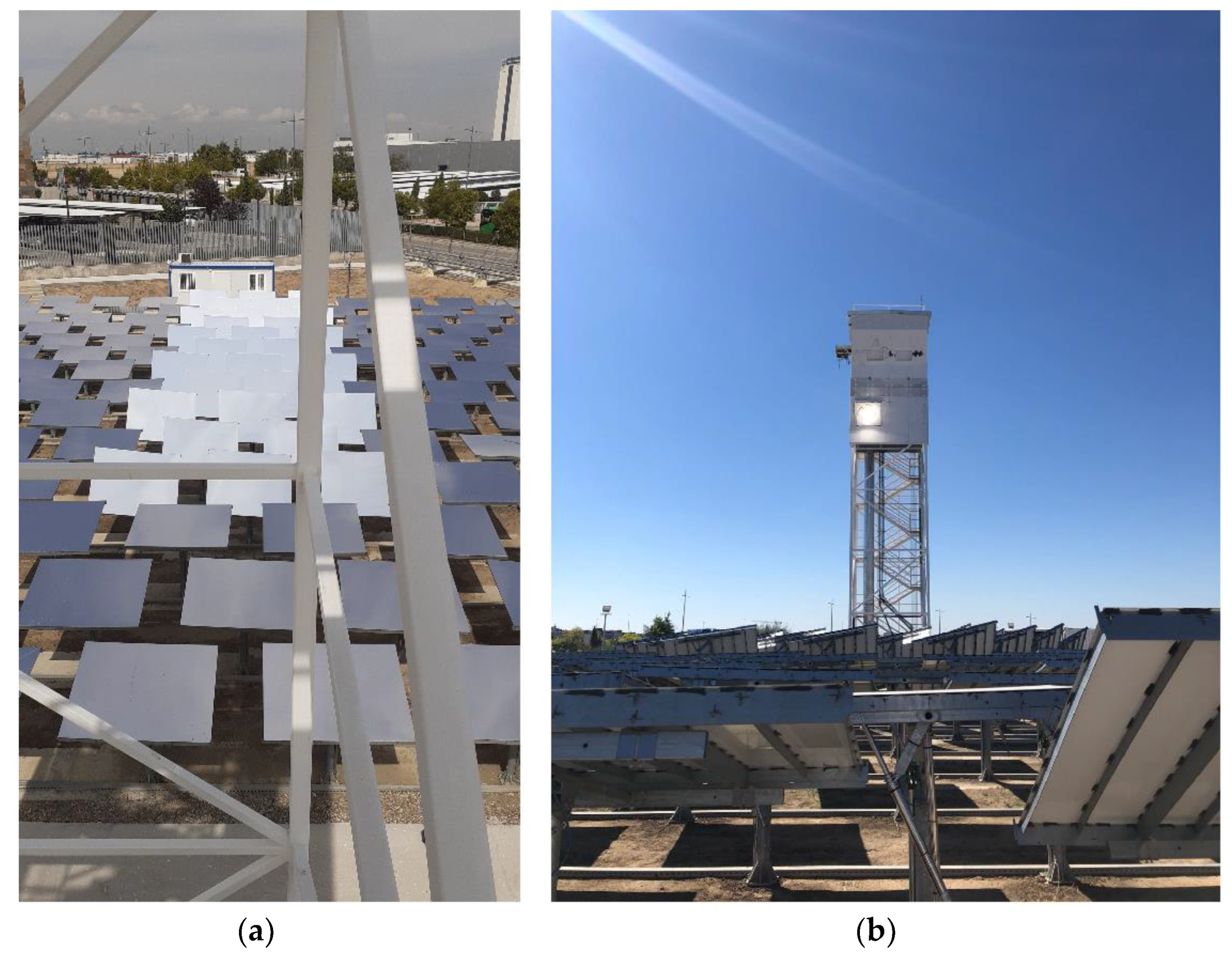
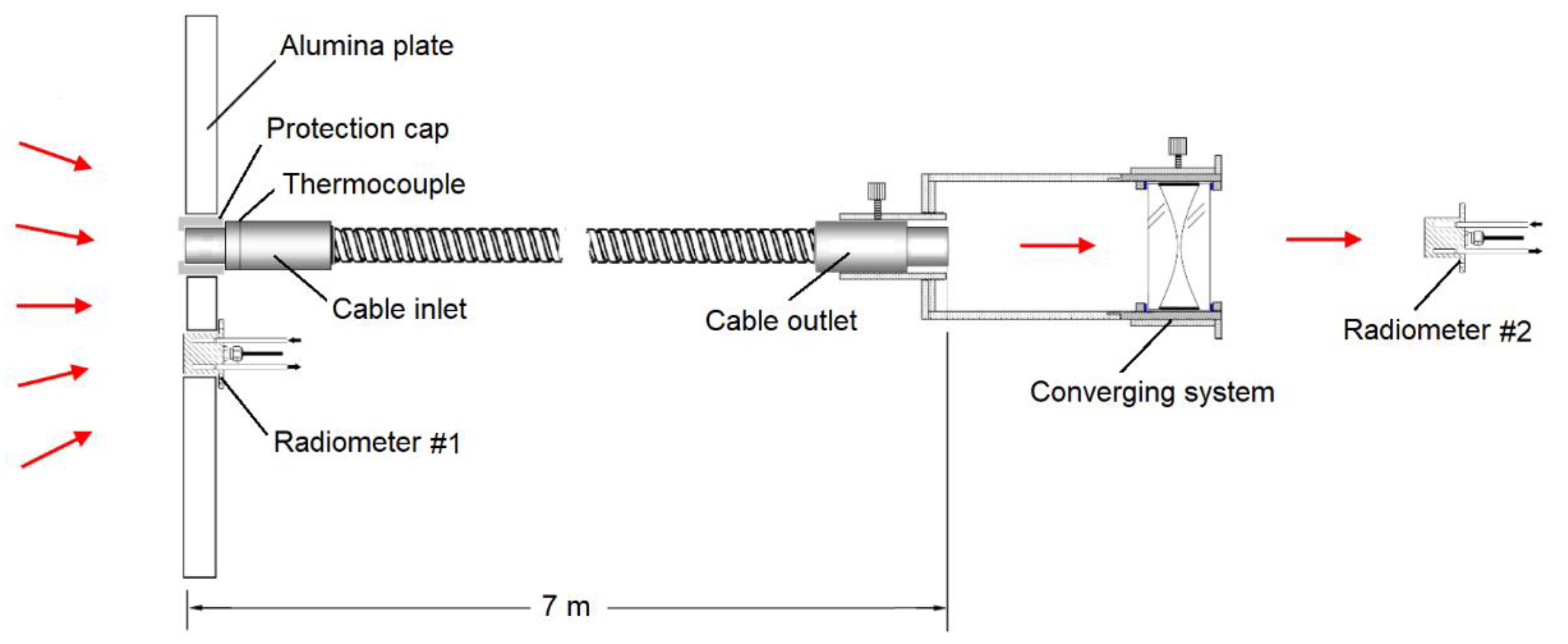
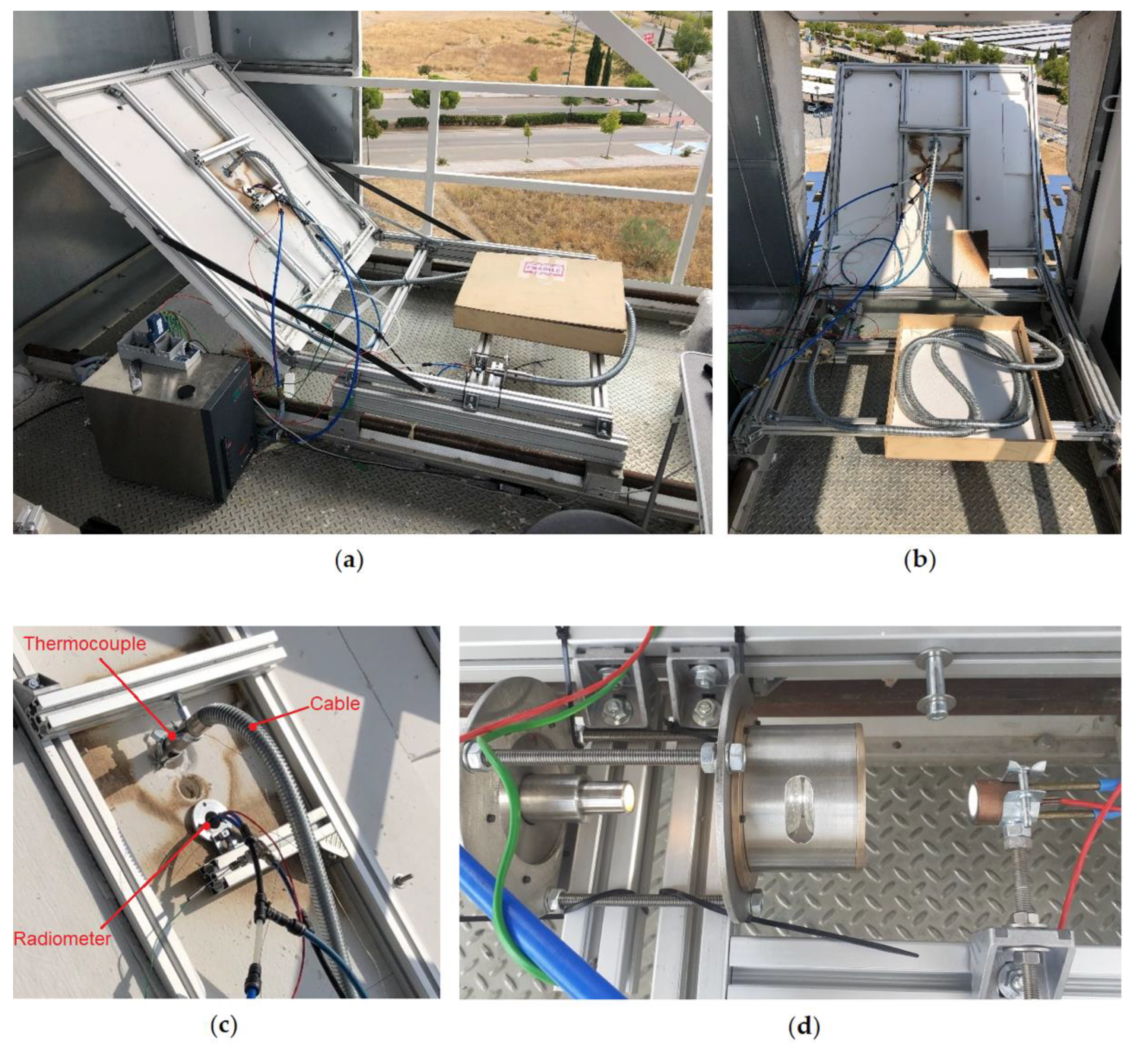
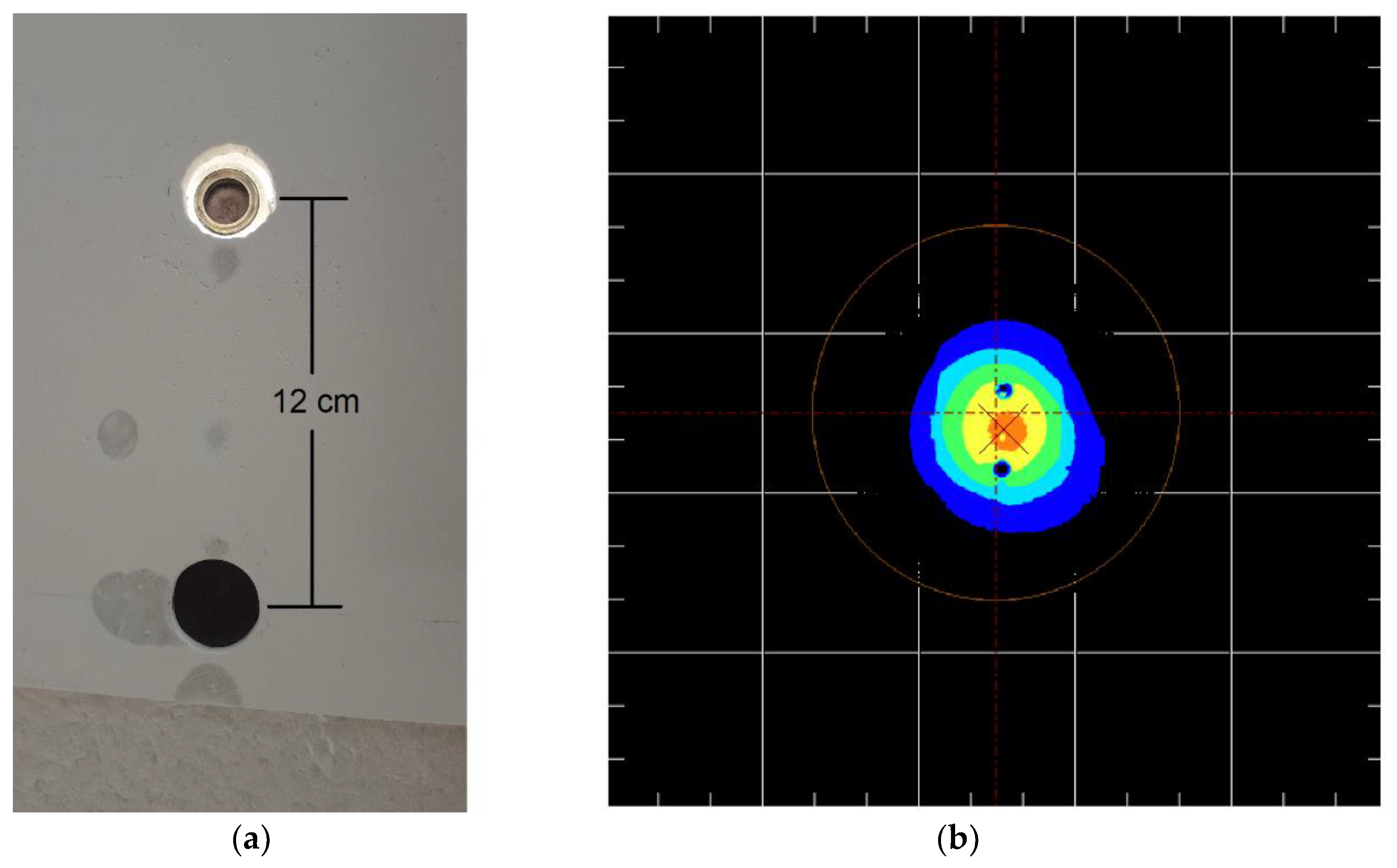
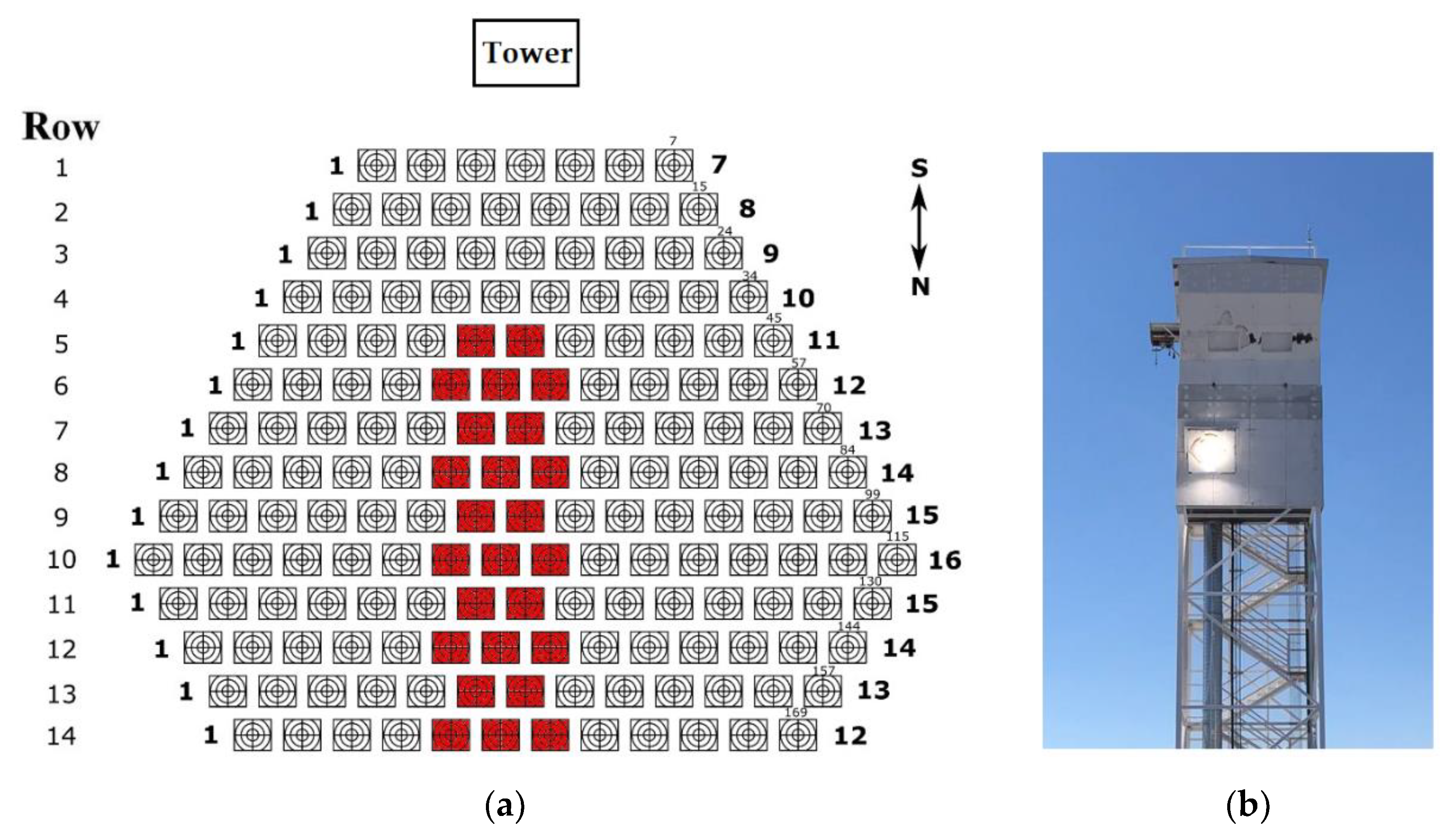

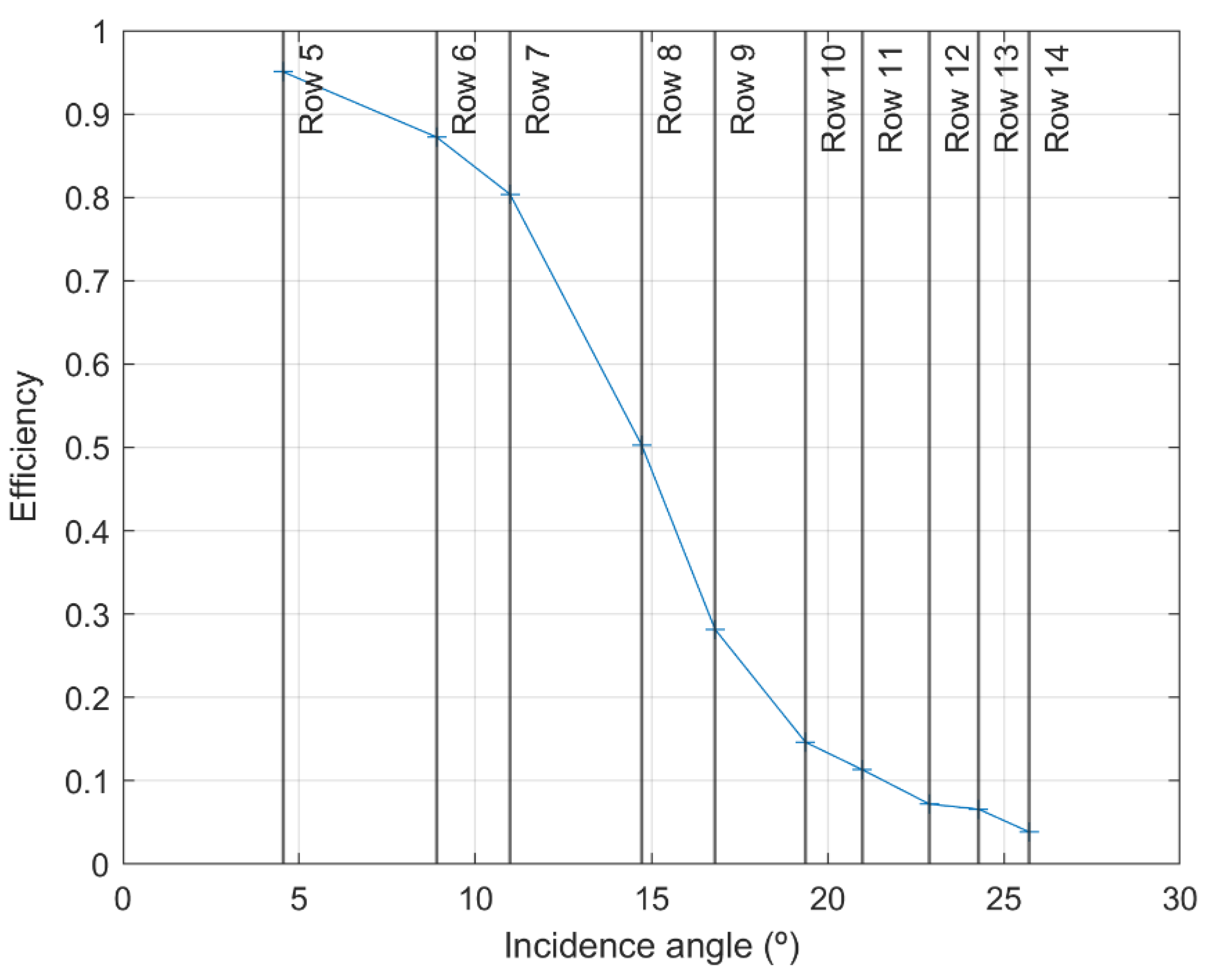
| Material | Glass Temperature [31] (°C) | Maximum Service Temperature [31] (°C) | Coefficient of Thermal Expansion [31] (10−6/°C) | RefractiveIndex * [32] | Abbe Number [32] |
|---|---|---|---|---|---|
| Silica glass | 957–1560 | 897–1400 | 0.55–0.75 | 1.45 | 67.8 |
| Polymethyl methacrylate (PMMA) | 85–165 | 42–57 | 72–162 | 1.48 | 53.2 |
| Polystyrene (PS) | 74–110 | 77–103 | 90–153 | 1.57 | 29.5 |
| Polycarbonate (PC) | 142–205 | 101–144 | 120–137 | 1.57 | 27.9 |
| Heliostat Row | 5 | 6 | 7 | 8 | 9 | 10 | 11 | 12 | 13 | 14 |
|---|---|---|---|---|---|---|---|---|---|---|
| Angle (°) | 4.5 | 8.9 | 11 | 14.7 | 16.8 | 19.4 | 21 | 22.9 | 24.3 | 25.7 |
| Heliostat Row | Angle (°) | DNI (W/m2) | Flux In (kW/m2) | Flux Out (kW/m2) | Efficiency (%) |
|---|---|---|---|---|---|
| 5 | 4.5 | 708 | 28.2 | 26.9 | 95.1 |
| 6 | 8.9 | 747 | 75.2 | 65.6 | 87.2 |
| 7 | 11 | 718 | 73.7 | 59.3 | 80.4 |
| 8 | 14.7 | 725 | 144.8 | 72.8 | 50.3 |
| 9 | 16.8 | 711 | 31.8 | 9 | 28.2 |
| 10 | 19.4 | 674 | 52.9 | 7.7 | 14.6 |
| 11 | 21 | 552 | 36.7 | 4.2 | 11.3 |
| 12 | 22.9 | 456 | 32.4 | 2.3 | 7.2 |
| 13 | 24.3 | 649 | 37 | 2.4 | 6.6 |
| 14 | 25.7 | 696 | 43.8 | 1.7 | 3.9 |
Publisher’s Note: MDPI stays neutral with regard to jurisdictional claims in published maps and institutional affiliations. |
© 2022 by the authors. Licensee MDPI, Basel, Switzerland. This article is an open access article distributed under the terms and conditions of the Creative Commons Attribution (CC BY) license (https://creativecommons.org/licenses/by/4.0/).
Share and Cite
Rosa, L.G.; De Almeida, G.; Garcia Pereira, J.C.; Martínez-Hernández, A.; González-Aguilar, J. A Method for Determination of the Transmission Efficiency of a Silica Optical Fiber Cable Using a Solar Power Tower. Materials 2022, 15, 1511. https://doi.org/10.3390/ma15041511
Rosa LG, De Almeida G, Garcia Pereira JC, Martínez-Hernández A, González-Aguilar J. A Method for Determination of the Transmission Efficiency of a Silica Optical Fiber Cable Using a Solar Power Tower. Materials. 2022; 15(4):1511. https://doi.org/10.3390/ma15041511
Chicago/Turabian StyleRosa, Luís Guerra, Guilherme De Almeida, José Carlos Garcia Pereira, Alejandro Martínez-Hernández, and José González-Aguilar. 2022. "A Method for Determination of the Transmission Efficiency of a Silica Optical Fiber Cable Using a Solar Power Tower" Materials 15, no. 4: 1511. https://doi.org/10.3390/ma15041511
APA StyleRosa, L. G., De Almeida, G., Garcia Pereira, J. C., Martínez-Hernández, A., & González-Aguilar, J. (2022). A Method for Determination of the Transmission Efficiency of a Silica Optical Fiber Cable Using a Solar Power Tower. Materials, 15(4), 1511. https://doi.org/10.3390/ma15041511







